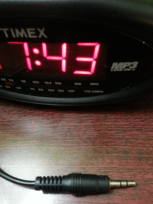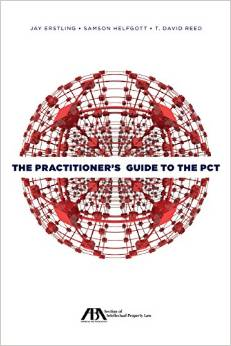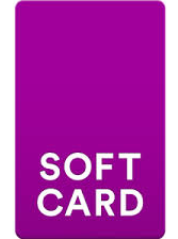 I checked into a hotel recently where the clock radio in the guest room had a conventional 3½-millimeter plug (see photo) which could be plugged into the guest’s smart phone or music player. This would permit playing music through the speaker of the clock radio. What I found amusing is what the manufacturer chose to write on the clock to let the user know about this feature — “MP3”. This is silly.
I checked into a hotel recently where the clock radio in the guest room had a conventional 3½-millimeter plug (see photo) which could be plugged into the guest’s smart phone or music player. This would permit playing music through the speaker of the clock radio. What I found amusing is what the manufacturer chose to write on the clock to let the user know about this feature — “MP3”. This is silly.
Practitioner’s Guide to the PCT now available faster, cheaper
The Practitioner’s Guide to the Patent Cooperation Treaty is published by the AB A. For the longest time you could only get it directly from the ABA and it cost a lot of money and took forever to arrive. Now you can get it faster and cheaper.
A. For the longest time you could only get it directly from the ABA and it cost a lot of money and took forever to arrive. Now you can get it faster and cheaper.
Continue reading “Practitioner’s Guide to the PCT now available faster, cheaper”
This weekend and your filings at WIPO
This weekend is when Americans (well, most Americans) change their clocks for Daylight Saving Time. This makes a big difference if you are going to e-file something at WIPO or fax-file something at WIPO.
USPTO closed today (Thursday)
Yes it’s another snow day at the Patent Office.
Design Day 2015
Registration is now open for the Ninth Annual USPTO Design Day. This important event will take place April 14, 2015.
Adopting a digital wallet redux
In a previous blog post I urged you to adopt a digital wallet. Players in the digital wallet arena are falling by the wayside, but this leave unchanged the important reason why you should adopt a digital w allet, namely that bad guys won’t be able to skim your credit card number as they would with your use of a swiped mag-stripe card. Most strikingly the digital wallet that I adopted, Softcard, has bitten the dust. Appropriately for this blog, nobody actually purchased the ill-fated Softcard. Instead someone merely purchased its intellectual property.
allet, namely that bad guys won’t be able to skim your credit card number as they would with your use of a swiped mag-stripe card. Most strikingly the digital wallet that I adopted, Softcard, has bitten the dust. Appropriately for this blog, nobody actually purchased the ill-fated Softcard. Instead someone merely purchased its intellectual property.
What caption to use when responding to a patent Office Action?
Most of us, when we were learning how to prepare a response to a patent Office Action in the USPTO, were taught to load up the caption with every conceivable piece of information. When I was first in practice I was taught to provide not only the application number but also the art unit, the Examiner’s name, the filing date, and the title of the invention. Some years later the USPTO introduced the “confirmation number” and this, too, went into the caption. Now I skip all of this and I use the application number and nothing else in the caption. Why?
Continue reading “What caption to use when responding to a patent Office Action?”
Why it’s a bad idea to generally authorize charges to your Deposit Account
There’s a fascinating thread over at the EFS-Web listserv today, about general authorizations to charge USPTO Deposit Accounts. As I will discuss in this blog post, I think that nowadays it is unwise to give a general-authorization-to-charge to the USPTO in a patent application.
Continue reading “Why it’s a bad idea to generally authorize charges to your Deposit Account”
Closure on changes in PCT fees (was “Four Fridays”)
Readers will recall my January 26 posting and my February 4 posting about the consequences of the decision on January 15 by the Swiss central bank to allow the Swiss Franc to rise to its natural level after over a year during which the bank had sought to cap the percentage difference between the Swiss Franc and the Euro. The Swiss Franc jumped 15 to 20 to 30 percent relative to various other currencies. I predicted that the International Bureau would seek to revise the “equivalent amounts” for the PCT international filing fee and other PCT fees payable to the International Bureau and would seek to make the revised fees effective much sooner than the usual delay of 3-4 months. Now the new fees have been set and indeed they will take effect sooner than the usual delay.
Continue reading “Closure on changes in PCT fees (was “Four Fridays”)”
USPTO will be closed on Tuesday, February 17
The weather reports for the Washington area call for “six to ten inches of snow” between now and noon on Tuesday. So the USPTO will be formally closed on Tuesday, February 17. This means that if you needed to file something on the 17th to satisfy some USPTO due date, it will be timely if filed on Wednesday the 18th.
Continue reading “USPTO will be closed on Tuesday, February 17”
